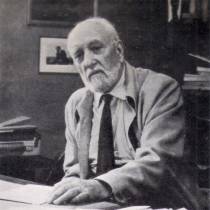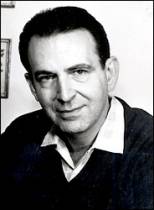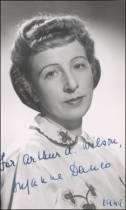 Ernest Alexandre Ansermet (November 11, 1883 – February 20, 1969) was a Swiss conductor. Ansermet was born in Vevey, Switzerland. Although he was a contemporary of Wilhelm Furtwängler and Otto Klemperer, Ansermet represents in most ways a very different tradition and approach from those two musicians. Originally he was a mathematics professor, teaching at the University of Lausanne. He began conducting at the Casino in Montreux in 1912, and from 1915 to 1923 was the conductor for Diaghilev's Ballets Russes. Traveling in France for this, he met both Debussy and Ravel, and consulted them on the performance of their works. During World War I, he met Stravinsky, who was exiled in Switzerland, and from this meeting began the conductor's lifelong association with Russian music.
In 1918, Ansermet founded his own orchestra, the Orchestre de la Suisse Romande (OSR). He toured widely in Europe and America and became famous for accurate performances of difficult modern music, making first recordings of works such as Stravinsky's Capriccio with the composer as soloist. Also, Ansermet was one of the first in the field of classical music to take jazz seriously, and in 1919, he wrote an article praising Sidney Bechet.
After World War II, Ansermet and his orchestra rose to international prominence through a long-term contract with Decca Records. From that time until his death, he recorded most of his repertoire, often two or three times. His interpretations were widely regarded as admirably clear and authoritative, though the orchestral playing did not always reach the highest international standards, and they differed notably from those of other famous 20th-century specialists, notably Pierre Monteux and Stravinsky himself. Ansermet disapproved of Stravinsky's practice of revising his works, and always played the original versions. Although famous for performing much modern music by other composers such as Arthur Honegger and Frank Martin, he avoided altogether the music of Arnold Schoenberg and his associates, even criticizing Stravinsky when he began to use twelve-tone techniques in his compositions. In Ansermet's book, Les fondements de la musique dans la conscience humaine (1961), he sought to prove, using Husserlian phenomenology and partly his own mathematical studies, that Schoenberg's idiom was false and irrational. In his last years, he and his ensemble surprised many by issuing discs devoted to Haydn, Beethoven and Brahms. These performances were not at all conventionally Germanic, and were much criticized at the time of their appearance, but during recent years their vivacity has come to be appreciated more.
In May 1954, Decca recorded Ansermet and the orchestra in Europe's first commercial stereophonic recordings. They went on to record the first stereo performance of the complete The Nutcracker by Tchaikovsky on LP (Artur Rodziński had already recorded a stereo performance on magnetic tape, but this had been released on LP only in mono). Ansermet also conducted early stereo recordings of Debussy's Nocturnes and the Prelude to the Afternoon of a Faun.
Ansermet was an ardent man who argued his opinions vehemently. He was notable in Britain for his argumentative rehearsals with British orchestras, who were used to the more jovial style of Sir Thomas Beecham or the more restrained manner of Sir Adrian Boult. His last recording, of Stravinsky's The Firebird, was made in London with the New Philharmonia Orchestra, which included a recording of the rehearsal sessions made as a memorial to him. He died in Geneva at the age of 85.
Ansermet composed some piano pieces and compositions for orchestra, among them a symphonic poem entitled Feuilles de Printemps (Leaves of Spring). He also orchestrated Debussy's Six épigraphes antiques in 1939.

Gérard Souzay (December 8, 1918 – August 17, 2004) was a French baritone singer, regarded as one of the best interpreters of mélodie (French art song) since Charles Panzéra and Pierre Bernac. He was born Gérard Marcel Tisserand, but later adopted the stage name of Souzay from a village on the river Loire. He came from a musical family in Angers, France. His parents had met at one of the first performances of Pelléas et Mélisande in 1902; his mother and two brothers were singers, and his sister, 15 years older, was the soprano Geneviève Touraine, who gave the first performance of Poulenc's Fiançailles pour rire in 1942. After his schooling at the Collège Rabelais in Chinon, he went to the Sorbonne in Paris to study philosophy, and while there he met the singer Pierre Bernac, who encouraged him to study singing. Souzay entered the Paris Conservatoire in 1940, studying with Claire Croiza and Jean-Emil Vanni-Marcoux. He actually began singing as a tenor, but in 1943, with advice from the leading operatic singer Henri Etcheverry, he became a baritone. He graduated from the Conservatoire in 1945 with two first prizes, the Prix de chant and the Prix de vocalise. While at the Conservatoire, he also tried his hand at composition and in 1942 three of his settings of poems by Paul Valéry were given a performance by Pierre Bernac. He went on to study voice with Bernac, although he subsequently expressed some differences with the latter's methods and ideas on pronunciation. He was eager not to limit himself to being a specialist in the French repertoire, and he made a detailed study of German lieder with Lotte Lehmann. Gérard Souzay's public appearances began in 1945 with recitals and concerts, including a performance of Fauré's Requiem in a centenary tribute to the composer at the Royal Albert Hall in London. He rapidly established an international career as a recitalist, admired not only in French music but also for his command of the German repertoire, especially Schubert and Schumann. In recital, his first accompanist was Jacqueline Bonneau (who had been his contemporary at the Paris Conservatoire), but she was reluctant to travel and from 1954 onwards he formed a close partnership with the American pianist Dalton Baldwin which continued for the rest of his career. Souzay's exceptional linguistic gifts enabled him to sing convincingly in 13 different languages including Hebrew, Portuguese and Russian. In contemporary music he performed in Honegger's La danse des morts and in the world première of Stravinsky's Canticum sacrum. The composer Jacques Leguerney (1906-1997) wrote many songs for Souzay and for his sister.
His operatic career began in 1947 in Cimarosa's Il matrimonio segreto at the Festival d'Aix-en-Provence, but it was not until the late 1950s that he extended his stage work - though even then it did not take precedence over his recitals. His roles included Monteverdi's Orfeo, Mozart's Don Giovanni and Almaviva in The Marriage of Figaro, Lescaut in Massenet's Manon, and Méphistophélès in Berlioz's La damnation de Faust. One of his favorite and most successful roles was Golaud in Debussy's Pelléas et Mélisande. He did little operatic work after the 1960s, but continued his recital career, finally retiring from performance in the late 1980s. He spent the last years of his life giving master classes in the United States, Europe and Japan: he was an inspiring teacher, preferring to work on phrasing and the mood of a song rather than French diction. He was a keen abstract painter, and in 1983 he published a book Sur mon chemin: pensées et dessins in which a selection of his paintings was accompanied by his written commentary, on art and life. He died at his home in Antibes in the south of France on 17 August 2004. 
Suzanne Danco (January 22, 1911 - August 10, 2000), was a celebrated Belgian soprano and mezzo-soprano. Suzanne Danco was born in Brussels and grew up in a Flemish background although French was her native language. She studied at the Conservatoire Royal de Bruxelles, and in 1936 she won a vocal competition in Vienna, after which the conductor Erich Kleiber recommended her to continue her studies in Prague with Fernando Carpi. She appears to have made her concert debut in Italy in 1940, and her stage debut in 1941 at the Genoa Opera, playing Fiordiligi in Mozart's Così fan tutte. She appeared in most of the major opera houses in Europe through the 1940s and 1950s, including at La Scala (Jocasta in Oedipus Rex by Stravinsky, and Ellen Orford in Peter Grimes), at the Teatro di San Carlo (Marie in Wozzeck), at the Royal Opera House Covent Garden (Mimi in La bohème), and at the festivals of Glyndebourne and Aix-en-Provence (Fiordiligi and Donna Elvira). Although her operatic repertoire was not large, she was noted for the range of musical styles that she undertook, from her Mozart roles (Fiordiligi, Elvira, Cherubino, and the Countess) to modern works by Berg, Britten and Stravinsky. Her tone was described as cool, clear and aristocratic, and well suited to French roles such as Melisande in Pelleas et Melisande and the Princess in Ravel's L'enfant et les sortilèges. Yet she also had success in some Italian works such as Il barbiere di Siviglia and La bohème. She is perhaps best remembered as a recitalist and concert artist, again in a wide range of styles from Bach cantatas to song cycles by Britten and de Falla, but especially in the repertoire of French mélodies, where her immaculate diction and innate command of style were heard to greatest advantage. Suzanne Danco retired from singing in 1970 but remained active as a teacher, both at the Accademia Musicale Chigiana in Siena and as a regular visitor to the Britten-Pears School at Snape. She died on 10 August 2000 at her home in Fiesole near Florence.
Gabriel Fauré: Requiem, Op. 48 Gérard Souzay, baritone Suzanne Danco, soprano L'Union Chorale de la Tour de Peilz
Suisse Romande Orchestra
Conductor: Ernest Ansermet
Rec.: 10-11.1955
|

